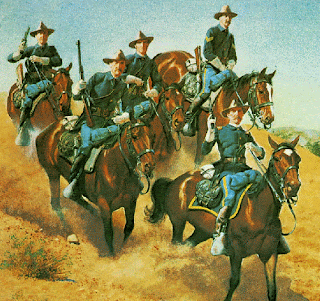 |
| First Kansas Territorial Capital Bldg at Fort Riley Kansas |
Historic Fort Riley
Fort Riley Kansas, established in 1853, has the distinction of being one of three frontier army forts that still exist today as an active army base.The other two forts are Fort Sill Oklahoma and Fort Bliss Texas. The area of Fort Bliss also extends into New Mexico.
The history of Fort Riley as well as the history of most frontier military forts was all about "Manifest Destiny" and the westward migration along both the Oregon and the Santa Fe Trails. Interestingly enough, Fort Riley was deemed by it's surveyors as being generally near the center of the North American continent. For this very reason it was initially named Camp Center.
 |
| Drawing of Custer's 1868 march to the Cheyenne village |
One of these historical structures is the home of George Armstrong Custer while he served at Fort Riley. The restored house, it's rooms and furniture are made to look like they would have back when Custer lived there for a few years in the late 1860's. During this period Custer was involved in actions against the Cheyenne Native Americans in Kansas, Oklahoma and eastern Colorado. The most historically significant action that Custer was involved in during this time was the Battle of Washita River or also referred to as the controversial Washita Massacre which occurred in present day Oklahoma in 1868.
The Custer House was constructed in 1855 and is made of native limestone. It is the only double set of surviving officer's quarters from the fort's early history. The Custer House is open from Memorial Day to Labor Day on Saturdays from 10A to 4P and on Sundays from 1P to 4P.
Yet another good visit at Fort Riley is Custer Hill. This is the main troop area on Fort Riley. It's the area where Fort Riley's soldiers live and work. The site includes barracks, the motor pools and various military offices.
 |
| Buffalo Soldier, Magee painting |
The Ninth and Tenth Cavalry, "buffalo soldiers", who were so active in the western frontier after the Civil War were also stationed at Fort Riley several times during their long history. The fact also is that the buffalo soldiers, established in 1866, served at many army posts during the latter 1800's from Montana to New Mexico and throughout Texas. Often they would pass through Fort Riley on their journey further west.
Links to five additional Western Trips articles you'll enjoy are below...
Historic Fort Reno
Frontier America
A Little Known Old Wild West Show
The Man-Made Wonder in Sedona Arizona
Drive the 13 Mile Route 66 in Kansas
 |
| U.S. Cavalry field uniforms 1876 |
Western historians are aware that many army forts along the western frontier were closed when the Indian Wars concluded during the late 1880's and particularly in 1890. Fort Riley was saved from these closures when Lt. Gen. Philip Sheridan requested within his 1884 report to Congress that the government make the fort "Cavalry Headquarters of the Army." It was this action in 1884 and it's approval that solidified Ft. Riley as a major army post. This museum is open Monday through Saturday from 9A to 4:30P and on Sundays from noon to 4::30 P.
The U. S. Cavalry Museum
The 10,000 square foot U.S. Cavalry Museum. Along with a plentiful exhibit of artifacts include uniforms and weapons equipment. Exhibits also include excellent oil paintings from well known military artists. Also included is the museum's Old Glory Antiques & Crafts Gift Shop.
 |
| Mountain Howitzer replica |
Another good stop to make while visiting Fort Riley is the Fort Riley 1st Infantry Division Museum. This museum tells the story of the First Infantry from its establishment in 1917 through the present day. The museum is open Monday through Saturday. from 10 AM to 4 PM.
Visiting Fort Riley
Fort Riley is located about a one hour drive west of the Topeka in northeastern Kansas. Fort Riley is about a three hour drive from Kansas City.
Fort Riley is an excellent addition to any family western road trip planner. The U.S. Cavalry Museum and the surrounding grounds and museums at Fort Riley exhibit a very large amount of American frontier history and army cavalry artifacts.
(Photos of buffalo soldier painting and howitzer cannon are from author's collection. Remaining photos and images are from the public domain)
US CAVALRY DOCUMENTARY VIDEO
View Larger Map

